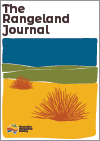Understanding the perceptions and motivations of those managing grazing lands and rangelands is critical to sustainability efforts. This research surveyed 367 Australian beef producers and identified four distinct producer groups on the basis of their perceptions of their industry’s sustainability, public support and attitudes towards industry emissions. The findings have implications for engaging producers and the success of programs and policies designed to influence acceptance, and adoption, of sustainability-related technologies and practices.
RJ24031 Abstract | RJ24031 Full Text | RJ24031PDF (770 KB) | RJ24031Supplementary Material (631 KB) Open Access Article





